« ORESTE » is an Associate Team between INRIA project-team ACUMES (formerly OPALE) and the Berkeley University team Connected Corridors (formerly Mobile Millennium), funded from 2012 to 2014, renewed from 2015 to 2017.
Numerical simulations
Discrete-time system optimal dynamic traffic assignment (SO-DTA) with partial control for horizontal queuing networks
The experimental analysis was conducted on a 8 mile corridor of Interstate 210 in Arcadia, California with a parallel arterial route.

- The physical properties of the network such as the capacity were obtained using the Scenario Editor software developed as part of the Connected Corridors project, a collaboration between the University of California Berkeley and California Partners for Advanced Transportation Technology (PATH).
- Calibrated fundamental diagram parameters, split ratios, and boundary data were also obtained from other parallel research efforts at Connected Corridors.
- The data used for calibrating these parameters was obtained from the Freeway Performance Measurement System (PeMS).
- We consider a prototypical one hour time horizon during the morning commute.
Numerical Results
We analyze the behavior of the freeway corridor in the event of a capacity drop caused by some incident. We assume that the capacity drop occurs at the fifth freeway road segment 10 minutes into the simulation and that it lasts for 20 minutes. The freeway capacity at segment five will be assumed to be reduced by half during this period, corresponding to a closure of two lanes (out of four) at the location of the incident.
The next figure shows the density profile corresponding to: (a) normal operation with capacity drop, (b) a capacity drop due to a two lane closure during the incident with no traffic diversion, (c) the same capacity drop with traffic being diverted to the parallel arterial, and (d) the change in the density profile due to the traffic diversion.
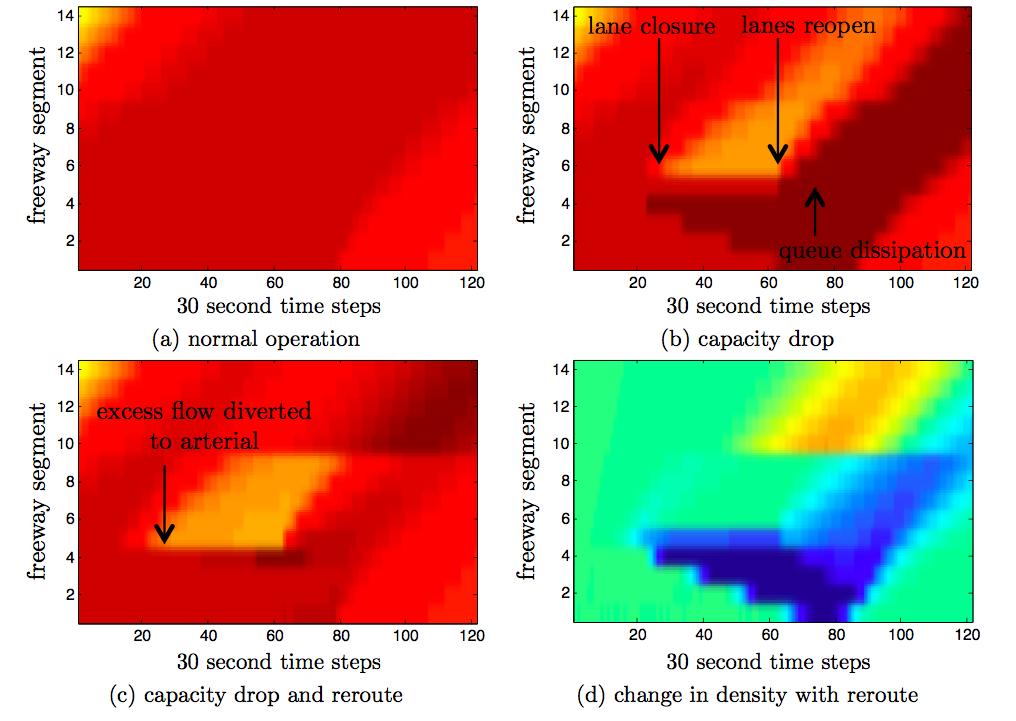
Rerouting the excess flow to the parallel arterial eliminates the bottleneck during the incident and improves the throughput of the freeway corridor. In this example, the parallel arterial is assumed to prioritize vehicles being routed from the freeway and the full arterial capacity is used for this purpose. However, in certain situations, municipalities may want to allocate some capacity of the parallel arterial for local traffic. In this case, the optimizer can be limited to only use a certain fraction of the capacity of the parallel arterial.
The next figure shows the density evolution when the arterial capacity allocated for rerouting freeway traffic is limited to 40% and 50% in comparison to full arterial utilization. The arterial capacity allocation can be controlled via the traffic signal controls along the arterial.
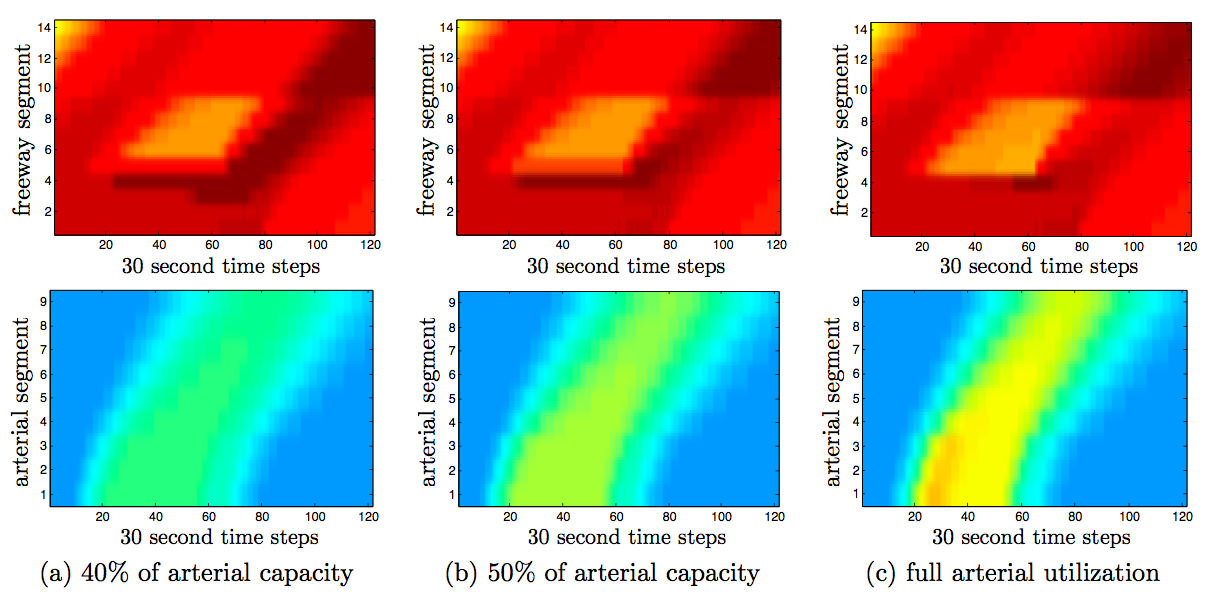
Optimal Coordinated Ramp Metering on Freeways
Adjoint Method for ramp-metering
We constructed a model of a 19.4 mile stretch of the I15 South freeway in San Diego, California between San Marcos and Mira Mesa.

- Link length data was obtained using the Scenario Editor software developed at UC Berkeley with the Connected Corridors project.
- Fundamental diagram parameters, split ratios, and boundary data were also obtained using calibration techniques developed by Connected Corridors.
- Densities resulting in free-flow speeds were chosen as initial conditions on the mainline and on-ramps.
- The data used in calibration was taken from PeMS sensor data.
Numerical Results
Density and queue profile of no-control freeway simulation. In the first 80 minutes, congestion pockets form on the freeway and queues form on the on-ramps, then eventually clear out before 120 minutes.
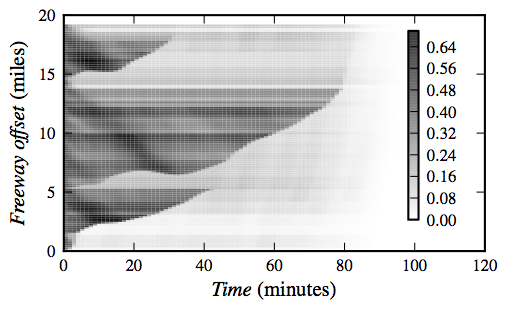
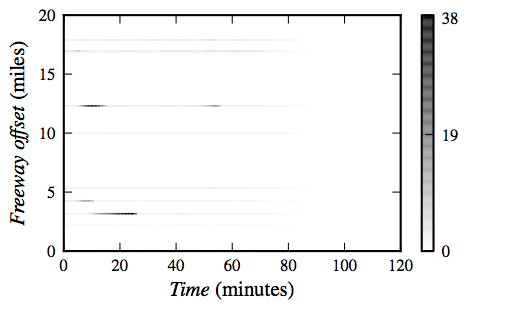
Profile differences for mainline densities and on-ramp queues. Evidenced by the mainly negative differences in the mainline densities and the mainly positive differences in the on-ramp queue lengths, the adjoint ramp metering algorithm effectively limits on-ramp flows in order to reduce mainly congestion.
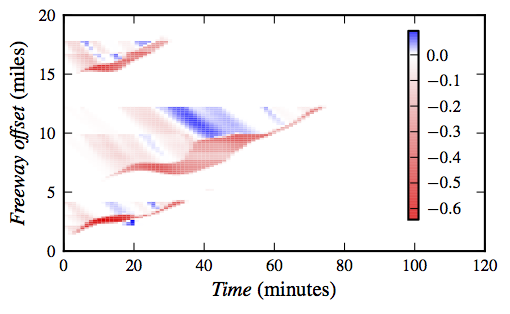
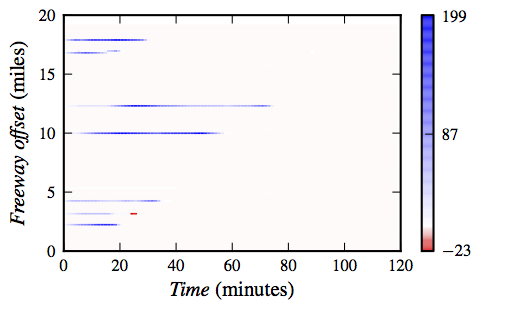




 Menu
Menu See also
See also Contact
Contact